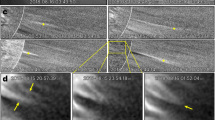Abstract
THE gas of the solar corona is at a temperature of several million degrees, orders of magnitude hotter than the underlying photosphere. The nature of the physical process that heats the solar corona (and the coronae of solar-type stars more generally) has been a long-standing puzzle. A number of plausible heating mechanisms have been proposed, but observations have so far been unable to discriminate between them1. Here we show that coronal heating exhibits scaling properties that should provide a powerful diagnostic of the underlying mechanism. The coronal magnetic field organizes the coronal plasma into loop-like features, which form the basic structural elements of the corona2. We demonstrate that the pressures and lengths of the coronal loops are statistically related, suggesting that the heating rate scales inversely with approximately the square of the loop length. Existing coronal heating theories make different predictions about what this scaling should be, and a model3–4 of energy dissipation by stressed coronal magnetic fields appears at present to be the most consistent with our observational result.
This is a preview of subscription content, access via your institution
Access options
Subscribe to this journal
Receive 51 print issues and online access
$199.00 per year
only $3.90 per issue
Buy this article
- Purchase on Springer Link
- Instant access to full article PDF
Prices may be subject to local taxes which are calculated during checkout
Similar content being viewed by others
References
Zirker, J. B. Solar Phys. 148, 43–60 (1993).
Bray, R. J., Cram, L. E., Durrant, C. J. & Loughhead, R. E. Plasma Loops in the Solar Corona (Cambridge Univ. Press, 1991).
Parker, E. N. Astrophys. J. 264, 642–647 (1983).
Parker, E. N. Astrophys. J. 330, 474–479 (1988).
Cargill, P. J. Solar Phys. 147, 263–268 (1993).
Kopp, R. A. & Poletto, G. Astrophys. J. 418, 496–505 (1993).
Tsuneta, S. et al. Solar Phys. 136, 37–67 (1991).
Klimchuk, J. A., Lemen, J. R., Feldman, U., Tsuneta, S. & Uchida, Y. Publs astr. Soc. Japan 44, L181–L185 (1992).
Efron, B. & Petrosian, V. Astrophys. J. 399, 345–352 (1992).
Lee, T. T., Petrosian, V. & McTiernan, J. M. Astrophys. J. 412, 401–409 (1993).
Porter, L. J. & Klimchuk, J. A. Astrophys. J. 454 (in the press).
Vesecky, J. F., Antiochos, S. K. & Underwood, J. H. Astrophys. J. 233, 987–997 (1979).
Rosner, R., Tucker, W. H. & Vaiana, G. S. Astrophys. J. 220, 643–665 (1978).
Hood, A. W. & Priest, E. R. Astr. Astrophys. 77, 233–251 (1979).
Spicer, D. S., Mariska, J. T. & Boris, J. P. in Physics of the Sun (eds Sturrock, P. A., Holzer, T. E., Mihalas, D. M. & Ulrich, R. K.) 181–248 (Reidel, Dordrecht, 1986).
Tucker, W. H. Astrophys. J. 186, 285–289 (1973).
Rosner, R., Golub, L., Coppi, B. & Vaiana, G. S. Astrophys. J. 222, 317–332 (1978).
Golub, L., Maxson, C., Rosner, R., Serio, S. & Vaiana, G. S. Astrophys. J. 238, 343–348 (1980).
Bateman, G. MHD Instabilities (MIT Press, Cambridge, MA, 1978).
Mikic, Z., Schnack, D. D. & Van Hoven, G. Astrophys. J. 361, 690–700 (1990).
Craig, I. J. D. & Sneyd, A. D. Astrophys. J. 357, 653–661 (1990).
Ionson, J. A. Astrophys. J. 226, 650–673 (1978).
Davila, J. M. Astrophys. J. 317, 514–521 (1987).
Hollweg, J. V. & Yang, G. J. geophys. Res. 93, 5423–5436 (1988).
Ofman, L., Davila, J. M. & Steinofson, R. S. Astrophys. J. 444, 471–477 (1995).
Penn, M. J. & Kuhn, J. R. Astrophys. J. 434, 807–810 (1994).
Gary, D. E. et al. Bull. Am. astr. Soc. 27, 971 (1995).
Lites, B. W. et al. Astrophys. J. 446, 877–894 (1995).
Klimchuk, J. A. & Canfield, R. C. in Solar Active Region Evolution: Comparing Models with Observations (eds Balasubramanian, K. S. & Simon, G.) 233–239 (Astr. Soc. Pacific, San Francisco, 1994).
Roumeliotis, G. Astrophys. J. (submitted).
Mikic, Z. & McClymont, A. N. in Solar Active Region Evolution: Comparing Models with Observations (eds Balasubramanian, K. S. & Simon, G.) 225–232 (Astr. Soc. Pacific, San Francisco, 1994).
Author information
Authors and Affiliations
Rights and permissions
About this article
Cite this article
Klimchuk, J., Porter, L. Scaling of heating rates in solar coronal loops. Nature 377, 131–133 (1995). https://doi.org/10.1038/377131a0
Received:
Accepted:
Issue Date:
DOI: https://doi.org/10.1038/377131a0
This article is cited by
-
Heliospheric Physics: Linking the Sun to the Magnetosphere
Space Science Reviews (2007)
-
On Solving the Coronal Heating Problem
Solar Physics (2006)
Comments
By submitting a comment you agree to abide by our Terms and Community Guidelines. If you find something abusive or that does not comply with our terms or guidelines please flag it as inappropriate.



